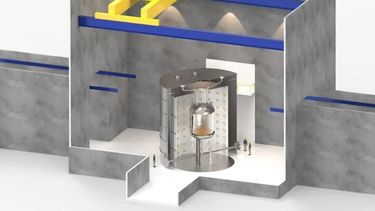- Scientists from the University of Sheffield are working with universities across the UK to build an advanced dark matter detector ten times the size of the previous record holder.
- An award of £8 million from the UK Research and Innovation (UKRI) Infrastructure Fund will support a consortium of UK universities to develop the detector over the next three and a half years.
- Dark matter is an invisible substance, thought to make up more than 85 per cent of the content of the Universe.
Scientists from the University of Sheffield are working with universities across the UK to build an advanced dark matter detector ten times the size of the previous record holder.
Dark matter is an invisible substance, thought to make up more than 85 per cent of the content of the Universe.
A preliminary award of £8 million from the UK Research and Innovation (UKRI) Infrastructure Fund will support a consortium of UK universities, led by Imperial College London. The consortium will work with the Science and Technology Facilities Council (STFC) Boulby Underground Laboratory over the next three and a half years.
Professor Dan Tovey and the research team from the University of Sheffield’s School of Mathematical and Physical Sciences and Nuclear Advanced Manufacturing Research Centre, will focus on developing major components of the detector and associated computing infrastructure, and engaging local, regional and national industry in building the experiment in challenging conditions deep underground. They will also work with colleagues from the University’s Advanced Manufacturing Research Centre Training Centre to develop a bespoke apprenticeship scheme that will train the technicians and engineers required to assemble the experiment.
As part of the world-leading Xenon LUX-ZEPLIN Darwin (XLZD) Consortium for dark matter research, the national team will develop initial plans and design components for the world’s largest and most advanced dark matter detector.
Once completed, this international experiment could be hosted at the UK’s deep underground science facility at Boulby mine in North Yorkshire.
One of the primary aims of the international XLZD Consortium is to build a definitive experiment to detect dark matter and explore its properties and origin.
The detector will consist of a large underground ‘thermos flask’ containing up to 100 tonnes of liquid xenon, which scientists believe will react subtly with dark matter as it passes through the earth.
Tiny, but detectable, flashes of light will be generated as evidence of the presence of dark matter particles and recorded for scientists to analyse.
Professor Dan Tovey, from the University of Sheffield’s School of Mathematical and Physical Sciences, said: “This is a tremendous opportunity for Sheffield to contribute to world-leading international research that could reveal the nature of most of the matter around us. The icing on the cake is that the mind-blowing results, that might transform our understanding of the universe, could be generated right here under our feet in Yorkshire.”
Professor Sean Paling, Director and Senior Scientist at STFC’s Boulby Underground Laboratory said: “To discover, or even be able to rule out the existence of dark matter, will be an enormous leap for science and transform our understanding of the cosmos.
“We are now closer than ever to achieving this and as long as we can come together as an international community, invest in the right instruments, and remain focussed on our search, there are potential big breakthroughs just around the corner.
“The XLZD experiment is the clear next step for dark matter research and will also be an important instrument for understanding wider fundamental questions about the content of our Universe. I’m delighted that Boulby, Imperial, and all contributing UK institutions are playing this key role in making it a reality.”
The project team comprises colleagues from the institutions Birmingham University, Bristol University, Edinburgh University, Imperial College London, King’s College London, Liverpool University, Oxford University, Queen Mary, University College London, Royal Holloway, University of London, Sheffield University, Sussex University and teams from STFC’s Daresbury and Rutherford Appleton Laboratories.



